It all began with NCIS.
Or, I should say, it really began with JAG. Because what many people don’t realize about NCIS (a.k.a. the most popular show on television) is that it’s actually a spin-off of the show JAG, the 100% accurate depiction of the day-to-day life of military lawyers.
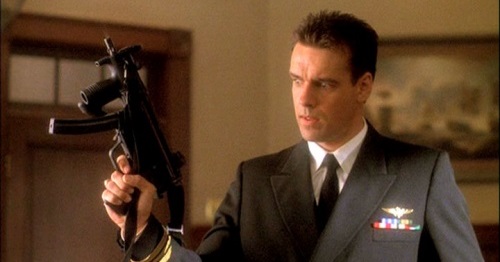
A two-episode arc of JAG, then in its 8th season, featured Agent Jethro Gibbs arresting CDR Harmon Rabb for a murder he didn’t commit. This turned into a back-door pilot for NCIS, which ultimately spun off two more shows, NCIS: Los Angeles and NCIS: New Orleans. JAG ran for 10 seasons; NCIS has run for 14; NCIS: LA for 8; and NCIS: NO for 3. That’s a whole lot television, all arguably part of the same shared creative universe.
So I began to wonder: just how big is the JAGiverse? Here’s what I came up with:
- JAG = 227 episodes × 43 minutes = 9,761 minutes
- NCIS = 318 episodes × 43 minutes = 13,674 minutes
- NCIS: LA = 181 episodes × 43 minutes = 7783 minutes
- NCIS: NO= 58 episodes × 43 minutes = 2494 minutes
- TOTAL = 33,172 minutes
That’s a lot. 33 thousand minutes comes out to 552 hours, or a little more than 23 days worth of content. If you started watching on December 1, and didn’t stop to eat or sleep, you’d just barely be done by Christmas.
But how does that compare to other shared TV-universes? Most importantly, what is the largest shared TV universe? I did a deep dive into the longest-running American TV shows, and came up with this:
Oh, what’s that? You can barely see JAG all the way down there? On reflection, it should be unsurprising: the largest TV universes are daytime soap operas, and it’s not even close.
The longest running scripted American TV show of all time was Guiding Light, which started as a radio show and ran on TV for 57 years. While I could not find a comprehensive list of Guiding Light episodes, the numbers I could find indicated something like 15,762 episodes that aired on television. These varied in length, starting with 15 minute blocks in 1952 (after transitioning from radio), expanding to 30 minutes in 1967, and then expanding again to the more familiar 60 minute format in 1977.
With some back of the envelope math, this puts Guiding Light at something like 496,000 minutes of total airtime. That’s 8,275 hours or 344 days. If you started watching Guiding Light on New Years Day and did not stop to eat, drink, or sleep, you would still not be done with it all before Thanksgiving.
The only shared universes that come even close to this total are other soap operas. As The World Turns, for instance, comes extremely close, clocking in by my math at somewhere around 492,000 minutes. [Note: because they are so close in total time, and because of the difficulty in finding good data on the actual lengths of episodes, it is possible that ATWT actually has more total time than Guiding Light.]
Those are the two longest running soap operas, so I gave up there. A whole bunch of other soap operas (e.g. General Hospital) are somewhere in the same general ballpark (i.e. hundreds of thousands of minutes), but you get the idea. Anything that’s run every weekday for a couple decades is going to have a whole lot of runtime. Indeed, the longest running soap operas are more than 10 times larger than a universe like the one shared by JAG and NCIS.
OK, so soap operas air pretty much year round, putting out 5 episodes per week, and they’ve been running continuously since the 1950s. No other kind of scripted show can hope to compete with this volume of content. So let’s leave the daytime soaps aside for a second, and ask a different question: What is the largest PRIMETIME scripted TV universe?
And it’s the Law and Order franchise (i.e. the Wolf-iverse) with the win! Coming in at a whopping 46,000 minutes of total airtime, the legal/police procedural is the clear winner of the longest-franchise/shared-universe crown. That number might even understate things a bit – it doesn’t include either Homicide: Life on the Street, which shared characters and had a lot of crossover with Law and Order, or the Chicago shared universe, which was also produced by Dick Wolf and was intended to be at least a spiritual spin-off of the Law and Order franchise.
From there, the top results are mostly dominated by a mix of (1) Police and legal procedurals; (2) Westerns; and (3) primetime soap operas.
There are a handful of sitcom franchises in there (notably, the Happy Days/Archie Bunker-verse which features a whopping *7* different shows), but these shows have a tough time competing because of the relative length of a single episode. Most dramas fill an hour of TV time (so 43 minutes of actual show), while sitcoms generally last only a half-hour (22 minutes of actual show). This makes it nearly impossible for sitcoms to catch up to the big dramatic franchises like Law and Order or CSI.
But how did other long-running shows build to their totals? I broke down some of the highest ranking dramas, and came up with this:
What’s interesting to note is that there’s no real pattern. Instead, you’ve got a bunch of different strategies – on one end of the spectrum you have an old-school western like Gunsmoke where the original series just ran for an insanely long amount of time. On the other end you have Star Trek, where the original series has long since been eclipsed by not one or two but three different extremely long-running and popular spin-offs. And in between you have a show like Law and Order or NCIS, which had two long-running series that account for most of the runtime, but still had some smaller spin-offs to pad the total.
Note that I’m defining “shared” universe very narrowly, including only shows that are created with the idea of being in the same universe as another show. This means we’re basically dealing with:
- Spin-offs; and
- Franchises
So yes, the Tommy Westphall shared universe is massive (including more than 400 different shows), but I don’t think it really counts. A single character crossing over to appear in a single episode is more of a wink at continuity than it is truly a sign of a shared reality.
This arbitrary choice is also a practical one – trying to document every crossover and the crossovers to the crossovers is a daunting task, and would make it nearly impossible to come up with a coherent answer.
Note also that I had to do some guesstimating on the exact length of episodes, so I generally assumed that an hour-long show has 43 minutes of actual content, and a half-hour long show has 22 minutes. Finally, I mostly left off stuff like hour-long specials and double episodes and the like. When you’re dealing with numbers this large, those should mostly come out in the wash.
And with those rules in place, Law and Order is the clear winner – the original series aired for 20 years, SVU has run for nearly as long, and even Criminal Intent had a not-insubstantial runtime. The short-liveed L&O Los Angeles and Trial by Jury had only a negligible effect on the total.
Ultimately, though, there’s more than one way to build a TV universe. If you’re a soap opera, you do it one relentless day and week at a time, burying the competition in a tide of soft-focus melodrama. If you’re in primetime, you have to do it one case, shoot out, or joke at a time.
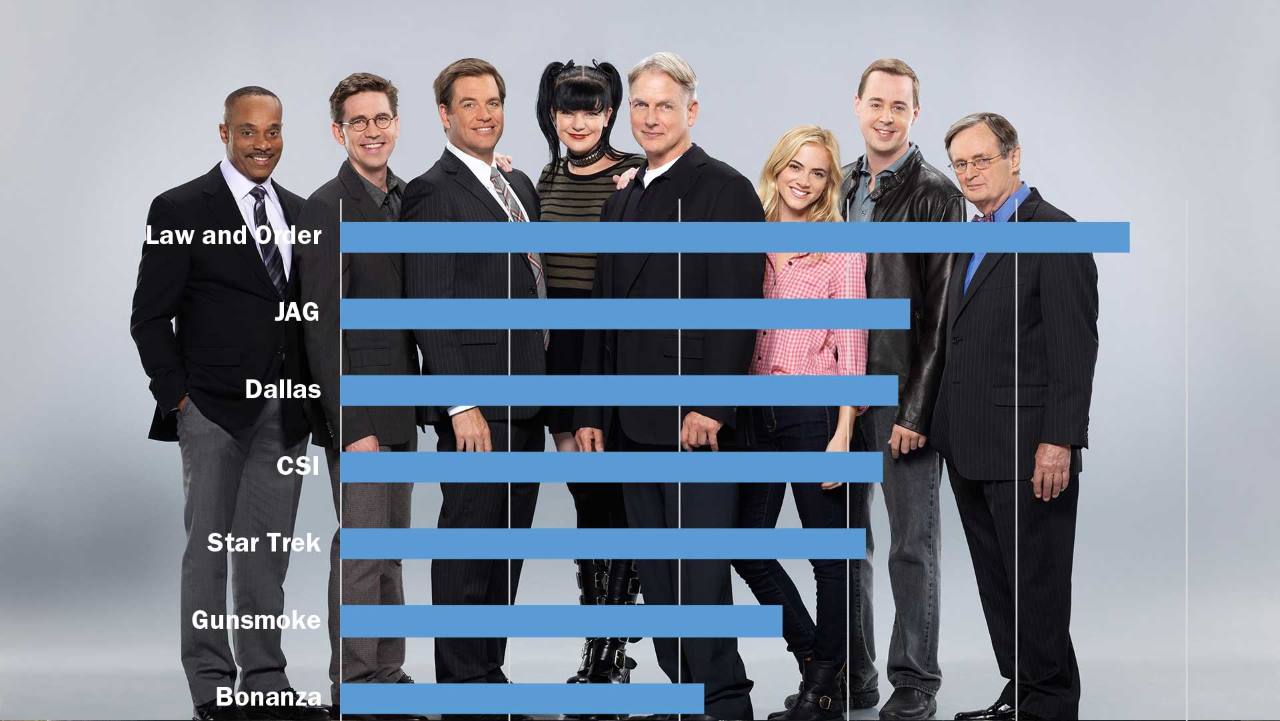
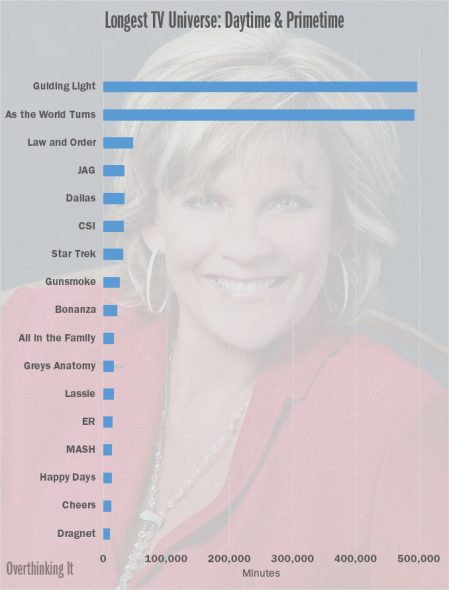
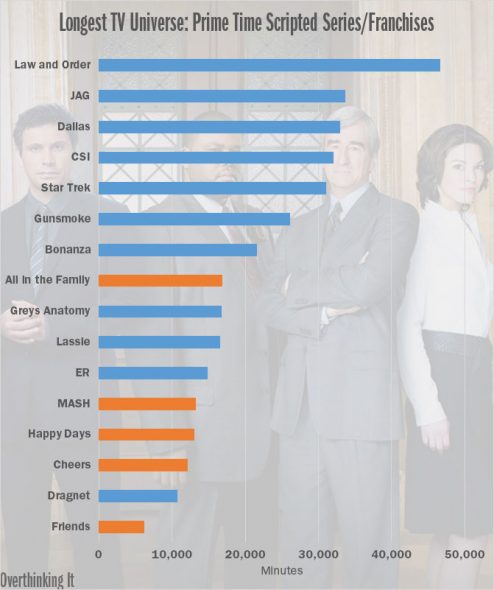
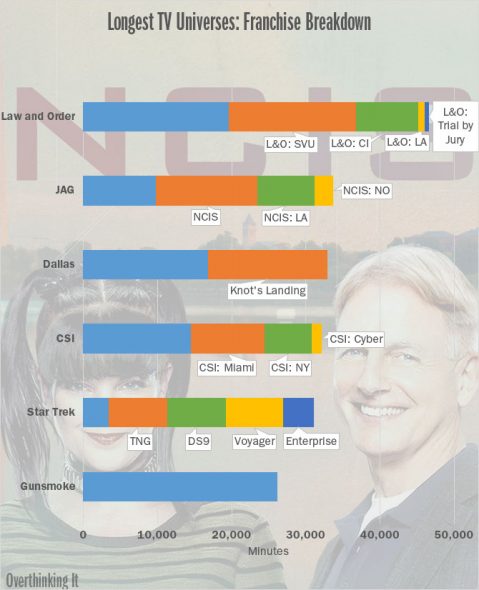
Should add another 13 episodes to Law & Order, courtesy of 2006’s short-lived Conviction, starring Stephanie March as her SVU character Alexandra Cabot.
https://en.wikipedia.org/wiki/Conviction_(2006_TV_series)
I wonder how animation would factor in. I have to think Family Guy+Cleveland Show is in the ballpark of Friends+Joey, and the Simpsons alone would beat both. And I feel like Transformers cartoons have been in near constant production for 30 years… quick estimate from wikipedia is over 800 episodes. And though I’m clueless on the subject of anime, it seems like a thing that would have a franchise with countless spinoffs.
Curious how the CW Arrowverse shows (Arrow, Flash, Legends of Tomorrow, and Supergirl, plus Constantine and Vixen depending on how you count) would be classified using this metric. They all take place in the same continuity, but they’re not exactly spin-offs, and “franchise” doesn’t feel right because they’re not branded like L&O. (They also haven’t been running long enough to register on your chart, but maybe in a few more years.)
So, not including Models, Inc, or the modern reboots, Beverly Hills 90210 and Melrose Place seem to be over 30k minutes.
But, the new 90210 features original cast in their original roles, so that’s the same universe, so that adds another 7k minutes.
I don’t think it beats Law & Order, but think it beats JAG.
https://en.wikipedia.org/wiki/Beverly_Hills,_90210_(franchise)
Wow, I definitely missed this one – was not really aware of the 90210 shared universe, and none of the individual series had quite enough episodes to get into the “most episodes” list that I used as a starting place. Including the new 90210 series, I calculate ~28,466 minutes for the Beverly Hills-iverse, which definitely puts in the running, up there w/ Bonanza and Gunsmoke.
(One thing to be careful about w/ the math – I’m not including commercial breaks. So each show is ~43 minutes, as opposed to the 60min runtime.)
This would be great as an interactive chart, especially if you could fill in some of the potential gaps, probably any show that would at least be as long as Friends (the shortest on the chart). A few to add:
Stargate
Bones
Smallville
The Closer
Perfect Strangers/Family Matters
I am sure there are more others could add.
I thought about Stargate too. A theatrical movie and three series that ran for a total of 17 seasons and more than 350 episodes. But I did the math and that still comes in at less than 16,000 minutes of showtime. It wouldn’t have made the chart!
Yeah, I had thought Stargate would make the cut as well – there are lots of shows/universes that I thought for sure would make it that ended up not even being in the ballpark.
I’m pretty sure the Cheers universe is shared with both St. Elsewhere and Frasier, both also long running dramas. That might raise the ranking.
Simpsons, Family Guy, and The Cleveland Show all share the same universe as well. (at least with the crossover)
You’re right that Cheers and St. Elsewhere crossed over with one another, but I considered those crossovers, as oppposed to being true “shared” universe (i.e. a franchise or spinoff)
And yeah, I despaired of including cartoons – too hard to keep track.
Power Rangers and ninja turtles are the same universe. Power Rangers is also the same (or an alternate) universe to all of the super sentai shows, which have many cross-overs.
Gundam has about 20 series, many of which have a lot of episodes, but only run for a single year (except Gundam Seed).
The issue with Gundam is relatively few of the series are in a shared continuity. Even counting every OVA and movie as well as TV episodes, the Universal Century timeline still comes in at fewer than 300 episodes spread out over 38 years
I was just watching a commercial for the newest Chicagoverse where they mentioned all the shows it includes and I was struck by how quickly and aggressively they’re trying to build it into a shared TV universe. I can’t wait until they go through enough public agencies that they have to start making shows like Chicago Water & Power and Chicago Sanitation.
If there was a like button, I would be all over it for this comment.
I think you should definitely add Homicide to Law & Order verse, since one Character John Munch transferred from Homicide to SVU, and according to Wikipedia, that same character appears on the X-Files and the following:
122 episodes (HLOTS)
4 episodes (L&O)
1 episode (The X Files)
326 episodes (SVU)
1 episode (The Beat)
1 episode (TBJ)
1 episode (Arrested Development)
1 episode (The Wire)
2 episodes (30 Rock)
So I actually considered the Munchiverse! I decided against including it since it was too hard to police the border between Munch crossovers and other more generic crossovers. THAT SAID, here’s what I found:
*: Looking at just EPISODES in which Munch appears, you’ve got ~15,902 minutes worth of TV.
*: If you look at all the SHOWS in which he ever made an appearance, it comes out to ~56,680 minutes.
So yes, the Munchiverse is massive indeed.
Yes!!! Go Law and Order!
I think Young and the Restless and Bold and the Beautiful are a shared universe. I haven’t done the math compared with Guiding Light but having 2 very long running soaps combined together might push it over as being longer.
As I was reading I also thought Matt Groening/Seth MacFarlane cartoons. But I think the comparison would be like calling DC and Marvel a shared universe. You might get the occasional pop-culture reference or even a full crossover episode but a late-game grab for cash does not a shared universe make.
It looks like you forgot the Dallas reboot, that’s definitely in the sale Dallas-verse.
Nice analysis. I’d like to pivot an expanded data set on the number of shows (expansiveness of the universe); and against a timescale (longevity of the universe).
I wonder where “Doctor Who” would fit in…..
And it’s a nitpick that probably won’t change any of the results, but there’s the Star Trek animated series that ran for 22 half-hour episodes in 1973-74. Not enough to show up on the graphics, but it does deserve some respect.
Just to comment on this, one figure I’ve seen is 5 weeks for Doctor Who, which is on the order of 50,000 minutes… so eat it Law and Order…
I’m not sure if that includes Torchwood/Sarah Jane Chronicles, but that won’t have much impact.
(Like the US, British soaps would knock that into a cocked hat, as the expression goes, not to mention soap operas from other countries…)
Here’s my quick calculations on Doctor Who, using primarily this wiki page
https://en.wikipedia.org/wiki/List_of_Doctor_Who_serials
694 original episodes at 22 minutes each – 15,268
1 TV movie at 89 minutes
134 new episodes at 43 minutes each – 5,762*
*this will be marginally low, as some specials ran up to 90 min
TOTAL – 21,119
Now to add the spin-offs (again some numbers may be low due to specials)
Torchwood: 41 x 43m – 1,763
Sara Jane: 54 x 22m – 1,188
K9: 26 x 22m – 572
Class: 8 x 43m – 344
Dreamland and Infinite Quest ~43m each – 86
Spinoff totals – 3,953
not insignificant, bringing our total to…
TOTAL WHONIVERSE: 25,072
Worth making the list, but not a top contender, I’m a bit surprised it clocks in under Star Trek personally.
Consider this with NCIS: NCIS Los Angeles crossed over with both Hawaii Five-O and Scorpion. Hawaii Five-O then crossed over with the reboot of MacGyver. Technically, they all then share the same universe. I know that many would consider a spin off and a crossover as being different, but there is still enough of a link to place them all in the same world…
You might be interested in the Make Room for Daddy/The Danny Thomas Show universe. The Danny Thomas Show spun off four series including The Andy Griffith Show that spun off another two series.
The Danny Thomas Show: 351 episodes
– The Andy Griffith Show: 249 episodes
— Gomer Pyle, U.S.M.C.: 150 episodes
— Mayberry R.F.D.: 78 episodes
— Goober & the Truckers’ Paradise (made-for-TV movie)
— Return to Mayberry (made-for-TV movie)
– The Joey Bishop Show: 123 episodes
– The Bill Dana Show: 43 episodes
– Make Room for Granddaddy: 24 episodes
That’s 1,018 half-hour episodes for 509 hours or 30,540 minutes (give or take) and with the two movies you get an additional 240 minutes. So in total, there are 513 hours or 30,760 minutes!
Then there are the “Hooterville” series that Paul Henning created.
The Beverly Hillbillies: 274 episodes + 1 made-for-TV movie
Petticoat Junction: 222 episodes
Green Acres: 170 episodes + 1 made-for-TV movie
That’s 666 half-hour episodes for 333 hours or 20,220 minutes!
Also, Law & Order is part of a larger “Wolf-verse” with the four Chicago series being part of that. So, Law & Order plus Chicago is still blowing away everything else.
Lady Aleena
By the way, I don’t know where you came up with the hours for the All in the Family universe. I got a higher number.
All in the Family: 205 episodes
– Maude: 141 episodes
— Good Times: 133 episodes
— Hanging In: 4 episodes
– The Jeffersons: 253 episodes
— Checking In: 4 episodes
– Archie Bunker’s Place: 97 episodes
– Gloria: 21 episodes
– 704 Hauser: 6 episodes
That’s 864 half-hour episodes for 432 hours or 25,920 minutes!
I am not sure about your Cheers number (though you do not have increments between the 10,000s).
Cheers: 275 episodes
– The Tortellis: 13 episodes
– Frasier: 264 episodes
That’s 552 half-hour episodes for 276 hours or 16,560 minutes.
And here’s the full Dragnet franchise…
Dragnet: 276 episodes (half-hour) + 1 made-for-TV movie and 2 theatrical movies
– Dragnet (1967): 98 episodes (half-hour)
— Adam-12: 174 episodes + 7 made-for-TV movies
— Emergency!: 129 episodes
— The New Adam-12: 52 episodes
– The New Dragnet: 52 episodes (half-hour)
– L.A. Dragnet: 22 episodes
It’s complicated. There are 423 half-hour episodes, 377 hour long episodes, and 8 movies. That’s approximately 610 hours or 36,600 minutes!
So, some are longer than thought. I did not include any crossovers, just spin-offs.
Lady Aleena
Two more, I think.
The Mary Tyler Moore Show: 168 episodes + 1 made-for-TV movie
– Rhoda: 110 episodes
– Phyllis: 48 episodes
– Lou Grant: 114 episodes
That’s 222 hours or 13,320 minutes.
Arrow: 116 episodes
The Flash (2014): 70 episodes
Legends of Tomorrow: 34 episodes
Supergirl: 44 episodes
That’s 264 hours or 15,840 minutes.
To sum up, here is where I am at:
Dragnet: 610 hours or 36,600 minutes
Danny Thomas: 513 hours or 30,760 minutes
All in the Family: 432 hours or 25,920 minutes
“Hooterville”: 333 hours or 20,220 minutes
Cheers: 276 hours or 16,560 minutes
Arrowverse: 264 hours or 15,840 minutes (add 4 hours or 240 minutes a week, in 4 weeks it will be above Cheers!)
Mary Tyler Moore: 222 hours or 13,320 minutes
Lady Aleena
EEK! I didn’t read your lengths were without commercials. However, the older the series is, the longer the episodes are. So, episodes from Star Trek were around 50 minutes long, however, current series length has dropped down to 40 minutes or less! It is getting worse every year.
Lady Aleena